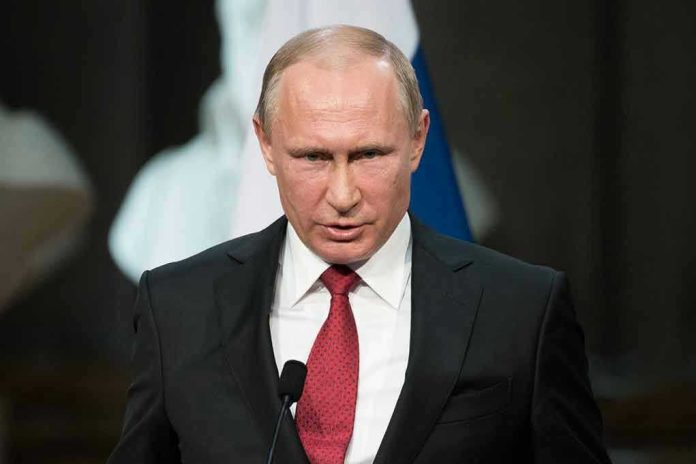
Russia’s claim of an “invincible” nuclear-powered missile with unlimited range isn’t just a flex of military muscle—it’s a warning shot across the bow of global stability, with stakes far beyond the next arms race.
Story Snapshot
- Putin’s Burevestnik missile test signals a new era in nuclear brinkmanship, boasting “unlimited range” and missile defense evasion.
- Western military and nonproliferation experts doubt the missile’s reliability and warn of severe environmental hazards.
- The program’s roots trace to Cold War-era experiments, but today’s political stakes are higher as U.S.-Russia tensions intensify over Ukraine.
- The missile’s very existence threatens arms control norms and may push the world closer to a dangerous technological and strategic spiral.
Putin’s “Invincible” Missile: A Strategic Message to the World
Vladimir Putin’s unveiling of the Burevestnik missile—the world’s first nuclear-powered, nuclear-capable cruise missile—marks Russia’s latest gambit in the game of strategic intimidation. Putin showcased the missile’s October 2025 test, claiming a 14,000-kilometer flight over 15 hours, and declared it immune to every missile defense system the West can muster. Russian officials, led by General Valery Gerasimov, amplified the narrative: this weapon is not just a technological marvel, but a direct response to U.S. and NATO encirclement of Russia.
American and NATO leaders, the intended audience of this demonstration, now face a dilemma. Do they pour billions more into missile defense, knowing Russia claims to have leapfrogged them? Or do they scramble for negotiations, risking the appearance of strategic weakness? The Russian military-industrial complex, meanwhile, basks in its moment of prestige, casting the Burevestnik as a symbol of Russian resolve amid Western sanctions and the ongoing Ukraine war.
Nuclear Propulsion: Technological Leap or Environmental Nightmare?
The Burevestnik’s core boast is its nuclear propulsion system, a concept reminiscent of the U.S. Project Pluto—abandoned in the 1960s for being too risky even by Cold War standards. Nuclear propulsion, in theory, offers “unlimited” range, but in practice, it spews radioactive exhaust, creating a flying Chernobyl. Past Russian tests reportedly caused radiation spikes and environmental scares, fueling criticism from nonproliferation experts like Jeffrey Lewis, who question both the missile’s practicality and the wisdom of resurrecting such hazardous technology.
Putin’s promises of invulnerability remain unverified, and Western analysts are skeptical that the missile could be safely or reliably deployed. The Burevestnik’s very existence is a provocation: it blurs the line between deterrence and recklessness, raising the specter of nuclear escalation through accident or miscalculation. Its true power may lie in psychological warfare—forcing adversaries to question their own security calculations as much as their technical capabilities.
Geopolitical Context: Cold War Echoes, Modern Stakes
The Burevestnik project was born from the ashes of arms control. After the U.S. withdrew from the Anti-Ballistic Missile Treaty in 2001 and NATO expanded eastward, Russia sought asymmetric means to restore its strategic balance. The missile’s public debut in 2018 was only the latest in a series of signals: Moscow will not stand idly by as the West encroaches on its perceived sphere of influence. The Ukraine conflict and escalating Western military aid to Kyiv have given new urgency to these demonstrations.
For Western policymakers, the missile is both a challenge and a puzzle. Do they believe the hype and escalate their own weapons programs, risking a new arms race? Or do they focus on the missile’s vulnerabilities—technical failures, environmental fallout, and the logistical nightmare of deploying nuclear-powered cruise missiles? Either choice comes with cost and risk, and both sides know it.
Experts Warn: Arms Control and Environmental Risks Loom Large
Arms control advocates and nonproliferation experts warn that the Burevestnik could erode decades of progress. If nuclear-powered delivery systems become the new norm, existing treaties and safeguards may become obsolete, and other nations could be tempted to follow Russia’s example. Environmental risks are not abstract: previous Burevestnik incidents caused radiation spikes and local contamination, and the long-term consequences of routine testing and deployment remain unmeasured and potentially catastrophic.
As the world fixates on the missile’s technical specifications, the real danger may be the precedent it sets—normalizing the pursuit of ever-riskier weapons for the sake of psychological advantage. The open question for the U.S., NATO, and the nonproliferation community is no longer whether Russia can build such a missile, but whether the world can afford the consequences of letting this new era of brinkmanship play out unchecked.
Sources:
BASIC (British American Security Information Council): Brief—Burevestnik















